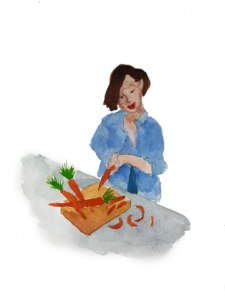Award Winning Author
Face Reading with Before & After Photos
To Peel or Not to Peel Vegetables: How Much Fiber Do You Actually Need?
Your Variable Fiber Needs

While a high-fiber diet is preferable, it’s not always apt. A high-fiber diet gets you more nutrition and supports regularity. But if your colon is inflamed, then it’s best to favor a non-irritating low-fiber diet until you’ve recovered. Here’s how to discern whether or not it’s best to peel that carrot.
But first, let’s look at fiber. As its name implies, fiber is coarse. If your bowels are irritated, then you don’t want to “scour” them with the roughage found in whole grains, seeds, nuts, beans, or the protective skins of broccoli, cucumber, and other produce. A low-fiber diet reduces undigested material passing through the colon to give, as it were, your innards a respite. A low-residue diet is even more fiber restrictive.
When Low Fiber Is Best
While a normal intestine thrives with fiber, softer foods are favored for the convalescing, elderly, very young, and those with autoimmune conditions. Yes, autoimmune disease too. Nearly 80 percent of the immune system lies in the gut, and several years before disease symptoms manifest, autoimmune conditions show in the intestinal lining. So even if autoimmune symptoms are in the thyroid, liver, kidneys, brain, or bones, it was gut malabsorption that helped set you up for it. Regaining gut health is a necessary step in putting all autoimmune conditions into remission. Better yet, pay attention now as a means of prevention.
So if you, like many people, have variable bowel health, or you’re being proactive, here’s an easy way to self-check. Pay attention to your lips. Traditional Chinese Medicine correlates your bottom lip with your large and small intestines. Ideally your lips are uniform in size, color and texture and have clearly defined borders, and the surrounding skin has normal color, tone, and texture.
If your mirror reveals something else, then experiment with a low-fiber diet. Should that not help, try increasing your fiber. If fiber doesn’t appear to be the issue, then explore other potential reasons, such as sensitivity to gluten or dairy. Or perhaps at this time you’ll do best by reducing FODMAPs, carbohydrates, or histamines. Once you’ve honed in on the diet that best serves you, the facial indicators around your mouth will recede.
Low Fiber Guidelines
So should you peel that carrot or not? While the fiber in broccoli stems, sweet potatoes, and apples is coarser than a carrot peel, fibrous it is. So depending upon your particular fiber needs and/or how fibrous the rest of your meal might be, it’s your call to peel it or not. Fiber notwithstanding, if the carrot is large and/or past prime, its peel is apt to have a bitter flavor, so skin it.
If you have diarrhea, intestinal cramping, colitis, Crohn’s disease, diverticulitis, fissures or the facial indicators described above, here are some low-fiber guidelines:
- Favor cooked foods, as cooking softens fiber, making it easier to assimilate.
- Favor younger, more tender vegetables that, by nature, are less fibrous. As an example, the fiber in foot-long bok choy must be tough enough to hold its mass upright, whereas the less coarse fiber in a baby bok choy only needs to hold up diminutive leaves.
- Favor white rice and refined grains over whole grains; avoid nuts and seeds.
- Remove and discard fibrous peels and seeds.
For examples of both normal and irregularly shaped bottom lips, see Identify Leaky Gut with Face Reading. For blogs that support colon health, see Metal Element Blogs. Or order your own Face Reading Report and I’ll personally guide you.


You say to cook foods but we all know that cooking destroys nutrients! Bad advice.
You are correct that high heat destroys water soluble vitamins and enzymes. But cooking does not destroy oil soluble vitamins, minerals, protein, fiber and carbohydrates. Furthermore cooking makes carbohydrates easier to assimilate. So enjoy some lightly cooked, raw or fermented foods for enzymes and water soluble vitamins. Otherwise there’s good reason to favor cooked foods.
I bought a Vitamix blender a while back and love it. Because it totally purees even broccoli stems, then their fiber wouldn’t be an irritant. Correct?
Here’s the question: Does fully pureed coarse fiber, like in broccoli stems, irritate the gut. The answer depends upon your gut! If it is inflamed, then fiber–especially coarse fiber–is an irritant. Reducing fiber size and cooking it, mitigates its roughness. But the particles are still rough (imagine a pulverized stainless steel scouring pad). The opportunity is for you to tune into your own system and increase awareness of what is medicinal for you.